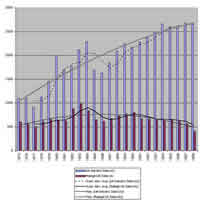|
2.3 1969-75
Following the launch of the Moulton, the UK cycle market grew reasonably consistently until 1975, when for the first time sales exceeded the 1950 level. During this time Raleigh’s sales growth closely mirrored that of the UK cycle industry, enabling the company to hold market share at around 60%.
In the late 1960s, Schwinn and other US cycle makers had discovered a grassroots Californian trend towards high-rise cycles for adolescents and were now capitalising on it. Responding to this, in 1969 Raleigh launched the Chopper in the USA. It was too expensive and too late for the American market but the following year it was released in the UK, where it was hugely successful. In its ten-year production, about 1.5m were sold in the UK alone. Importantly, it pushed the price point for toy bicycles to unimagined heights. It was launched at 31 guineas (£32.55, = about £292 today), when hitherto the most expensive Raleigh child’s bike, the Chico, cost just £19.99.
In 1970 Raleigh ceased moped production and again concentrated on cycle sales. Two years later an 18" wheel scaled-down version of the Twenty was introduced, and in 1973 another model aimed at youngsters was launched, the Commando. The following year, Raleigh invoked the break clause in their agreement with Alex Moulton and stopped making his cycles. The company also retired the RSW and concentrated all small-wheel production on the Twenty series, reputedly their biggest seller at the time.
In the USA between 1970 and 1972, demand for lightweight ten-speed cycles increased forty-fold. Raleigh Record and Grand Prix models, based on Carlton designs, sold there in massive numbers. At one point they were being made in Nottingham, at Worksop (by Carlton), in the Netherlands by Gazelle, by Raleigh Ireland and possibly even in Malaysia.
By the eve of the period on which this paper focuses, Raleigh was therefore doing reasonably well. It had survived the virtual death of utility cycling in the UK and its poor management of the Moulton affair. It was now benefiting from the renewed interest in cycling that the maverick small-wheeler had generated and which was being sustained in the UK by a gradual increase in popularity of other types of cycle, such as ten-speed drop-handlebar machines. The Moulton’s commercially viable legacy was safely in-house, in the form of the profitable and popular Twenty and its derivatives. With the Chopper, Raleigh had created a new market in the UK and other developed countries for expensive toy cycles, which it continued to exploit. Moreover, in contrast to toys such as the Chopper, it offered fine Carlton lightweights to the discerning enthusiast. Thus, in 1975 Raleigh enjoyed record sales 599,000 units in the UK, although market share was beginning to decline slightly.
Overseas, Raleigh was also doing quite well. In the Netherlands, not only was it was selling 50,000 cycles a year under its own name: Gazelle, the leading Dutch manufacturer, now owned by Raleigh, was selling a further 250,000. Raleigh’s Canadian factory had recently doubled in size to produce 150,000 units a year. In the USA, there was a new factory in Oklahoma, supported by a network of large, modern warehouses in New Jersey, Massachusetts, Illinois, California and Oklahoma.
Importantly, Raleigh still benefited from Britain’s imperial heritage, with huge sales of black, 28" wheel roadsters in former colonial territories, particularly in Africa. The company had recently opened a new factory in Nigeria, where Raleigh was selling some 200,000 cycles a year. Producing large numbers of old-fashioned roadsters was what Raleigh did most profitably.
3. Raleigh Products – 1975-1999
3.1 Sales trends: 1975-87
Annual sales of cycles in the UK during the last quarter of the 20th century rose dramatically, from around 1.1m to 2.7m. Sales were flat initially, rose steeply in the late 1970s and early 1980s, dipped somewhat in the mid 1980s, then grew until the end of the century.
Raleigh’s sales during the same period were flat rather than steeply increasing. In broad terms , the company started and ended the period selling about 1º2m cycles a year, and during the middle of the period were selling about 3º4m. Raleigh’s good and bad years tended to reflect those of the industry as a whole, but during the whole period the company was steadily losing market share – down from 54% to around 20%.
Much of this loss of market share is ascribable to imports. In 1970, the UK imported a mere 27,000 cycles – about 4% of the UK market. Meanwhile the country exported more than a million bikes, 38 times as many as it imported, and the majority of them Raleighs. By 1975, while exports remained at about the same level, there were nine times as many imports. Six years later exports were overtaken by imports, mainly from Europe and including makers such as Peugeot and Puch. From 1980 to 1986, imports accounted for about 40% of the UK market.
Then came the mountain bike boom and another step change. Adding to the European imports, bicycles from the USA and Taiwan started to come in. In 1987, for the first time, UK consumers bought more imported bikes than British, and imports soon took about 60% of annual UK sales. 
Click the chart to enlarge
Raleigh UK sales plotted against sales for the whole UK cycle industry, 1975-98. The polynomial curves show the 'big picture' for the whole period; the 3-year moving average curves give a more precise view.
 ............................................. .............................................
|





